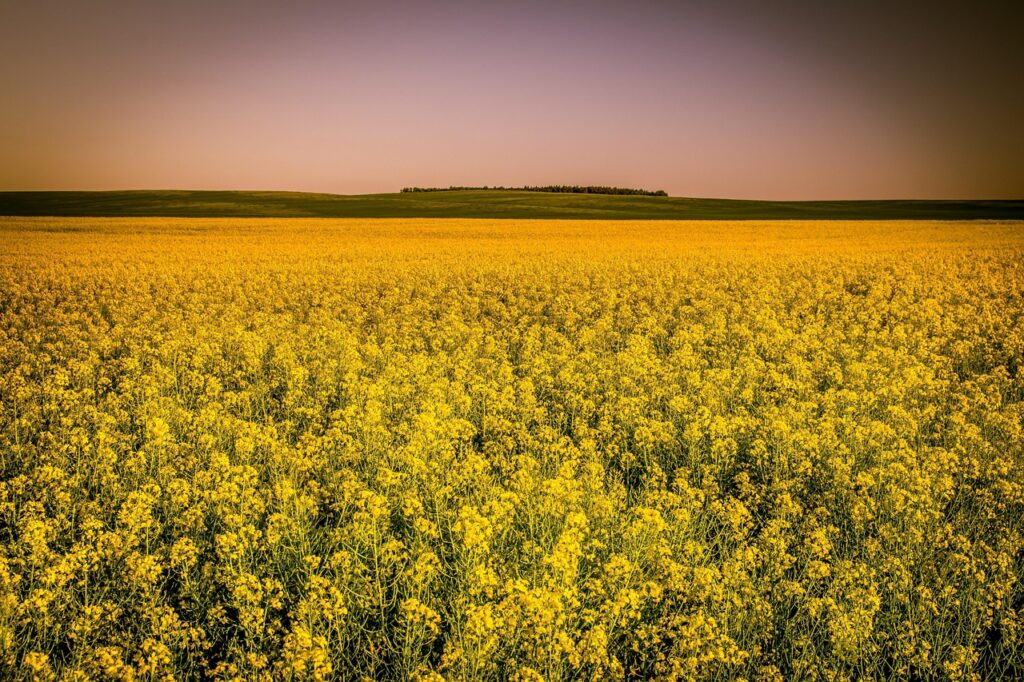The common belief is that buying local food always means lower CO₂ emissions. While this often holds true, the reality is more nuanced. Emissions vary greatly depending on the type of crop, soil management, and regional farming practices. This is where the concept of the Carbon Footprint of Products (CFP) becomes critical. A carbon footprint is the total amount of greenhouse gases released across a product’s lifecycle — from production and processing to transport and consumption — expressed in carbon dioxide equivalents (kgCO₂e). By quantifying not just CO₂ but also potent gases like methane and nitrous oxide, CFP helps us understand the true climate cost of our food. Measuring these emissions allows producers and consumers to identify hotspots and act on strategies to reduce them, such as optimizing fertilizer use or improving soil management. In this article, we explore a striking case study: Canadian rapeseed (canola), wheat, and peas, recently compared to international competitors in a new open-access paper.
- Study Overview — How the Comparison Was Done
- Key Findings — Why Canada Stands Out
- Rethinking “Food Miles” — Not Always a Simple Equation
- Why Canada’s Farming Is So Efficient
- Implications for Policy, Business, and Procurement
- Plant Hack — Everyday Actions We Can Take
- Conclusion — A New Perspective on Food and Climate
- Additional References
Study Overview — How the Comparison Was Done
The study focused on three Canadian crops: rapeseed (canola), non-durum wheat, and peas. Results were benchmarked against the same crops grown in Australia, France, Germany, and the United States. The researchers followed ISO 14067 standards to calculate carbon footprints at the farm-gate stage — that is, from cultivation up to the point of leaving the farm. The analysis considered soil organic carbon (SOC) changes, nitrous oxide (N₂O) emissions from fields, fertilizer use, and fuel consumption. Export scenarios were also modeled, asking: even after long-distance shipping, do Canadian products remain lower in emissions compared to local production in importing countries? This is where the idea of a “break-even distance” comes in — the point at which transport emissions cancel out Canada’s production advantage.

Key Findings — Why Canada Stands Out
Lower Emissions at the Production Stage
Canadian crops consistently showed lower emissions during production compared to competitors. This was driven mainly by two factors: lower field-level nitrous oxide emissions and net carbon gains in soils. Even when excluding soil carbon gains, Canadian crops often outperformed others. One exception was rapeseed, where Australia’s dry climate kept N₂O emissions lower, sometimes giving it a relative advantage.
Low-Carbon Advantage Survives Long-Distance Shipping
Perhaps the most striking finding was that Canada’s advantage persists even after shipping. In extreme cases, Canadian rapeseed or peas shipped to Western Europe could undergo as many as 17 additional trans-Atlantic trips before their carbon footprint equaled that of European-grown crops. That equates to circling the Earth more than three times. When SOC changes were included, transport accounted for 21–88% of total emissions depending on crop and destination, yet Canada’s edge remained.
Crop-Specific Emission Profiles
For rapeseed, 35% of emissions came from fertilizer production, 47% from field N₂O, and 7% from fuel. Including SOC reduced totals further. For wheat, 38% came from fertilizer, 37% from N₂O, and 8% from fuel; adding SOC cut overall emissions by 62%. For peas, 62% came from N₂O, 19% from fuel, and 10% from fertilizer management; adding SOC reduced totals by 87%.
International Comparisons
Differences between countries were stark. For peas, Canadian production emitted only 0.03 kgCO₂e per kilogram of product, compared to 0.64 in France and 1.05 in Germany — roughly 21 times and 34.5 times higher, respectively. This highlights how local conditions and practices can radically alter climate impacts.
Note: These values represent farm-gate emissions only, not downstream processing or retail. Export scenarios add transport emissions on top of these.
Rethinking “Food Miles” — Not Always a Simple Equation
The general rule that local food is lower in emissions remains valid in many contexts. Most studies agree that the majority of emissions come from production, not transportation, meaning food miles usually play a smaller role. However, this study illustrates that when production practices are exceptionally favorable, long-distance shipping may still result in a lower overall footprint than local alternatives. This does not negate the benefits of local food, but it adds nuance: we must look at how food is produced, not just where it is grown. Consumers should consider farming practices and environmental performance alongside distance when making sustainable choices.

Why Canada’s Farming Is So Efficient
Canada’s advantage stems from widespread adoption of conservation tillage and no-till farming. By minimizing soil disturbance, these practices allow soils to retain more carbon, effectively pulling CO₂ out of the atmosphere. Reduced summer fallow, continuous cropping, and the return of crop residues and manure further increase soil organic matter. These practices together create significant net carbon gains in soils. However, such gains are not infinite; soils eventually reach a new equilibrium where additional carbon storage slows down. Moreover, the impact of no-till practices varies by soil type and climate, meaning results in Canada may not directly apply elsewhere.
Beyond carbon storage, better nitrogen management is crucial. Adjusting fertilizer rates and timing, or using coated urea, reduces nitrous oxide emissions — another major driver of agricultural footprints. Improved machinery efficiency and smarter use of inputs also contribute to Canada’s low numbers. Together, these factors show that sustainable farming is not about a single practice but about combining multiple strategies.
Implications for Policy, Business, and Procurement
Procurement standards should move beyond simple distance-based metrics and include farm-level practices. Evaluating how soils are managed and how nitrogen is applied gives a more accurate picture of environmental performance. Switching sourcing regions can be a fast, effective way to cut supply-chain emissions, particularly for crops like pulses and oilseeds. Carbon labeling and standardized accounting — aligned with ISO 14067 — help businesses and consumers make consistent, transparent choices. Finally, supporting farmers through incentives for conservation tillage, residue return, and smart fertilization can scale these benefits globally.
Plant Hack — Everyday Actions We Can Take
First, when possible, choose products labeled with carbon footprint data and favor those with lower values. If such information isn’t available, don’t hesitate to ask brands to disclose it — consumer demand drives transparency. Second, minimize food waste. Wasted food equals wasted emissions from production. Freezing, preserving, or creatively reusing leftovers reduces your household footprint. Third, consider small shifts toward plant-based meals. Replacing even one daily meal with legumes or grains can meaningfully lower emissions without requiring a complete diet overhaul. Finally, support “soil-friendly” products from farmers who practice conservation tillage, cover cropping, or organic matter return. Your purchases act as votes for more sustainable agriculture.
Conclusion — A New Perspective on Food and Climate
This study does not overturn the idea that local food is often best. Instead, it highlights an important exception: in some cases, the production advantages of certain regions outweigh the emissions cost of transport. Canada’s example shows that thoughtful soil and nitrogen management can dramatically reduce emissions. If similar practices are scaled worldwide, agriculture could play a far bigger role in climate mitigation than currently recognized. As consumers, we can reinforce this shift. Next time you’re in the supermarket or farmers’ market, pause to consider not just how far your food traveled, but how it was produced. That awareness — and your choices — help shape a lower-carbon food future.

Additional References
- Poore, J. et al. “Reducing food’s environmental impacts through producers and consumers.” Science (2018)
- ISO 14067:2018 “Greenhouse gases — Carbon footprint of products — Requirements and guidelines.”
- Ritchie, H. “You want to reduce the carbon footprint of your food? Focus on what you eat, not whether your food is local.” Our World in Data (2020)
- Li, M. et al. “Global food-miles account for nearly 20% of total food-system emissions” Nature Food (2022)



コメント